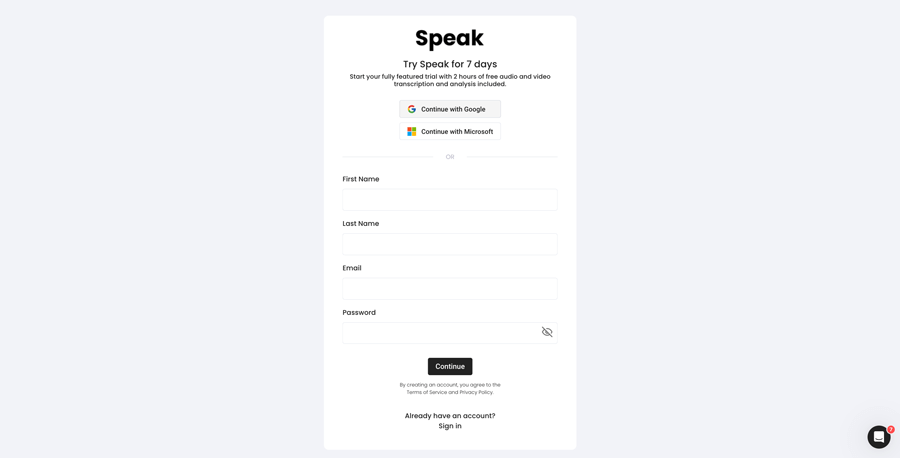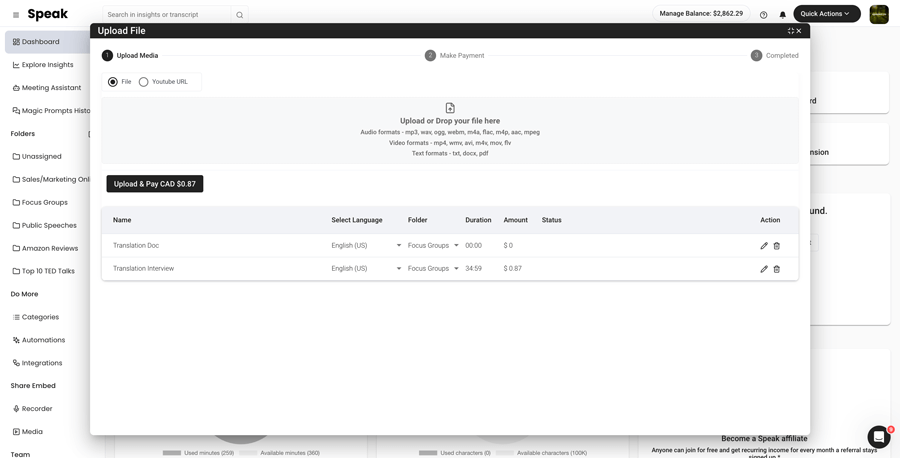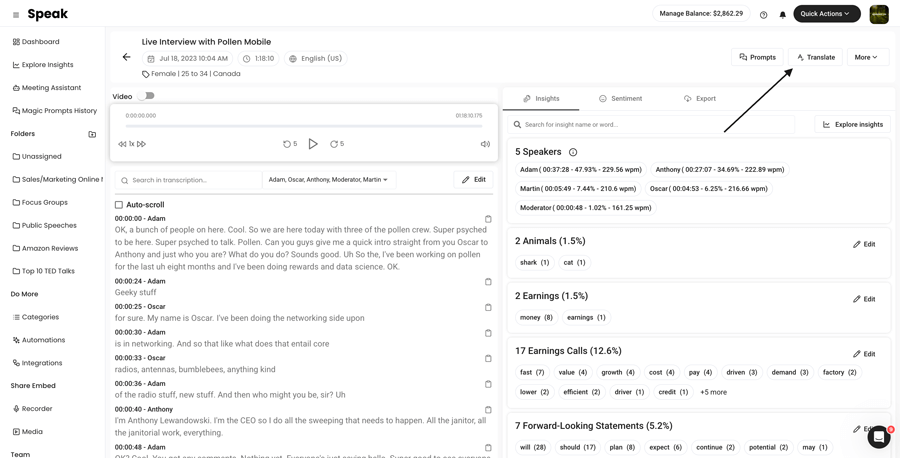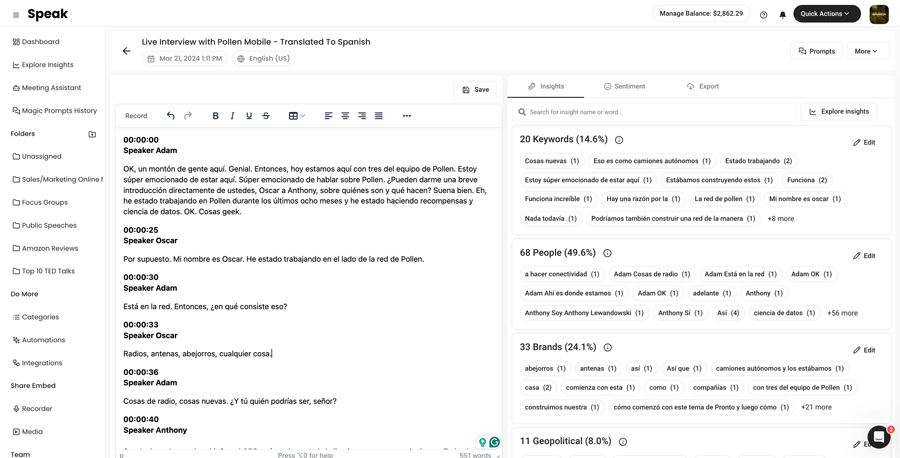How To Translate German to Japanese
Translating German to Japanese is super simple!

Step 1: Register for Speak
Register for Speak using this link.
Once you register, you can instantly begin translating your German to Japanese file(s).

Step 2: Upload Your German file(s)
As soon as you log in, you will be redirected to the dashboard.
Once there, you can select the Quick Action "New Upload".
In Speak, you can seamlessly upload, transcribe and translate audio, video and text files all at once!

Step 3: Translate Your German file(s) to Japanese
Once the file is uploaded, simply visit your file and select "Translate".
If it is an audio and video file, Speak will ask you if you want to keep the speaker names and timestamps in the translation.
Want to translate many files at once? No problem!
You can view the files you want to automatically translate from German to Japanese from the folder level and instantly translate as many files as you need with our artificial intelligence translation in just a few clicks.

Step 4: That's It! View, Analyze, Modify & Export Your New Japanese file(s)
Once the translation is done, you will be alerted and you will see a new document in the same folder your original file is in.
The file will be named the same but with a dash indicating that it is the translated version.
Need support with your German translation?
We are always here and happy to help at Speak!
Just send us a message on live chat on the bottom right corner and we will ensure you are set up for success.
Interested in translating German or other languages to different languages? View our entire list of supported translation languages here.
Automatic, accurate, instant AI translation from German to Japanese is here for you.
Register for Speak using this link and begin translating German to Japanese today.
Unlock the World of Opportunities with German to Japanese Translation
As globalization connects every corner of the world, the need for seamless communication across languages has never been more critical. For businesses, researchers, and individuals navigating the realms between German and Japanese-speaking territories, the power of accurate translation cannot be overstated. Introducing Speak AI, your premier partner in breaking down linguistic barriers with state-of-the-art AI translation technology. Discover the unparalleled advantages of transforming your German content into Japanese and vice versa, opening doors to a myriad of opportunities.
The Age of Automatic Translation: A Game-Changer for German-Japanese Communication
In an era where time is of the essence, automatic translation emerges as a revolutionary solution. Speak AI's advanced automatic translation capabilities ensure that your content—be it audio, video, or text—is flawlessly translated from German to Japanese and back. But what makes this technology stand out? Let’s delve into the specifics.
The Power of AI in Translation
At Speak AI, we harness the capabilities of Natural Language Processing (NLP) and large language models, coupled with generative AI, to provide translations that are not just accurate, but contextually nuanced. This means that whether you are a researcher looking to comprehend German academic papers or a business aiming to communicate with your Japanese clients, our AI-driven approach ensures that your message is conveyed with the precision it deserves.
Cost and Time Efficiency
The days of waiting for human translators and bearing hefty costs are behind us. Speak AI's translation services are designed to deliver swift and cost-effective solutions without compromising quality. Explore how our platform can transform weeks of work into mere hours, enabling you to allocate your resources more efficiently.
Benefits Across Sectors
Whether you are in academia, business, technology, or any field in between, the need for clear and precise communication transcends borders. Speak AI caters to a broad spectrum of needs, from translating technical documents and business contracts to adapting educational materials for international students. Discover how our services facilitate smoother transactions, enhanced understanding, and stronger connections across cultures.
Key Features:
- AI Meeting Assistant for real-time translation in web conferencing
- Data visualization for insightful analysis of translated content
- Generative AI for nuanced, natural translations
- Compatibility with audio, video, and text formats
Exploring the German-Japanese Linguistic Landscape
The German and Japanese languages, each with their unique histories and cultural significance, offer fascinating insights when examined side by side.
Global Influence and Demographics
German, the most widely spoken native language in the European Union, boasts over 130 million speakers. It holds official status in Germany, Austria, Switzerland, Belgium, and Luxembourg. Meanwhile, Japanese, primarily spoken in Japan, is the native language of about 128 million people. While these languages operate within distinct cultural and geographical spheres, their global impact, particularly in business, technology, and science, is immense.
Fun Facts About German and Japanese
- German is known for its long compound words, while Japanese utilizes a system of characters borrowed from Chinese, alongside two phonetic alphabets.
- Japanese has three writing systems: Kanji, Hiragana, and Katakana, making it a unique linguistic phenomenon.
- Germany and Japan are both renowned for their contributions to automobile engineering and technological innovation.
Differences and Similarities
While German and Japanese may seem worlds apart, both languages share a commitment to precision and clarity. German syntax allows for flexible sentence structure, thanks to its cases, while Japanese syntax is more rigid, often requiring context for understanding. Interestingly, both cultures value indirect communication, where the implication is as crucial as what is explicitly stated.
Embracing the Future with Speak AI
In today’s fast-paced global environment, the ability to communicate across linguistic barriers is not just an advantage—it’s a necessity. Speak AI’s cutting-edge German to Japanese translation technology empowers businesses, researchers, and individuals to harness the full potential of their work, without the constraints of language. With our commitment to accuracy, efficiency, and customer satisfaction, supported by a 4.9 rating on G2 and over 150K users, your linguistic needs are in capable hands.
Ready to transcend linguistic barriers and connect with a broader audience? Join the Speak AI community today and embark on a journey of endless possibilities.
FAQs: German and Japanese Cultural and Linguistic Curiosities
What locations are German and Japanese popular?
German has significant presence in Central Europe and is influential in the EU, while Japanese is predominantly spoken in Japan, with diasporas across the globe.
What are some fun facts about German and Japanese?
From Germany's Marktplatz to Japan's bustling Shibuya Crossing, both languages navigate unique cultural landscapes. German's lyrical literature contrasts with Japanese's poetic Haiku, illustrating the beauty in their diversity.
What are the differences and similarities between German and Japanese?
Despite their differences in structure and syntax, German and Japanese both offer rich expressions of nuance and indirect communication, reflecting deep cultural values of precision and respect.
Embark on your journey of breaking linguistic barriers with Speak AI, where language is no longer a barrier, but a bridge to endless possibilities.
Translate German To These Other Supported Languages:
- Translate German-to-Arabic (Egypt)
- Translate German-to-Arabic (Iraq)
- Translate German-to-Arabic (Israel)
- Translate German-to-Arabic (Jordan)
- Translate German-to-Arabic (Kuwait)
- Translate German-to-Arabic (Lebanon)
- Translate German-to-Arabic (Oman)
- Translate German-to-Arabic (Palestinian Authority)
- Translate German-to-Arabic (Qatar)
- Translate German-to-Arabic (Saudi Arabia)
- Translate German-to-Arabic (Syrian Arab Republic)
- Translate German-to-Arabic (United Arab Emirates)
- Translate German-to-Arabic Modern Standard (Bahrain)
- Translate German-to-Armenian
- Translate German-to-Bulgarian
- Translate German-to-Catalan
- Translate German-to-Chinese (Cantonese, Traditional)
- Translate German-to-Chinese (Simplified)
- Translate German-to-Chinese (Traditional)
- Translate German-to-Croatian
- Translate German-to-Czech
- Translate German-to-Danish
- Translate German-to-Dutch
- Translate German-to-English
- Translate German-to-English (Australia)
- Translate German-to-English (India)
- Translate German-to-English (Ireland)
- Translate German-to-English (New Zealand)
- Translate German-to-English (Scottish)
- Translate German-to-English (South African)
- Translate German-to-English (United Kingdom)
- Translate German-to-English (United States)
- Translate German-to-Estonian
- Translate German-to-Farsi
- Translate German-to-Finnish
- Translate German-to-French
- Translate German-to-French (Canada)
- Translate German-to-German
- Translate German-to-German (Swiss)
- Translate German-to-Greek
- Translate German-to-Gujarati
- Translate German-to-Hebrew
- Translate German-to-Hindi
- Translate German-to-Hungarian
- Translate German-to-Icelandic
- Translate German-to-Indonesian
- Translate German-to-Irish
- Translate German-to-Italian
- Translate German-to-Japanese
- Translate German-to-Kannada
- Translate German-to-Korean
- Translate German-to-Latvian
- Translate German-to-Lithuanian
- Translate German-to-Malay
- Translate German-to-Malayalam
- Translate German-to-Norwegian
- Translate German-to-Persian
- Translate German-to-Polish
- Translate German-to-Portuguese
- Translate German-to-Portuguese (Brazilian)
- Translate German-to-Portuguese (Portugal)
- Translate German-to-Romanian
- Translate German-to-Russian
- Translate German-to-Slovak
- Translate German-to-Slovenian
- Translate German-to-Spanish
- Translate German-to-Spanish (Mexico)
- Translate German-to-Swedish
- Translate German-to-Tamil
- Translate German-to-Telugu
- Translate German-to-Thai
- Translate German-to-Turkish
- Translate German-to-Ukrainian
- Translate German-to-Vietnamese



